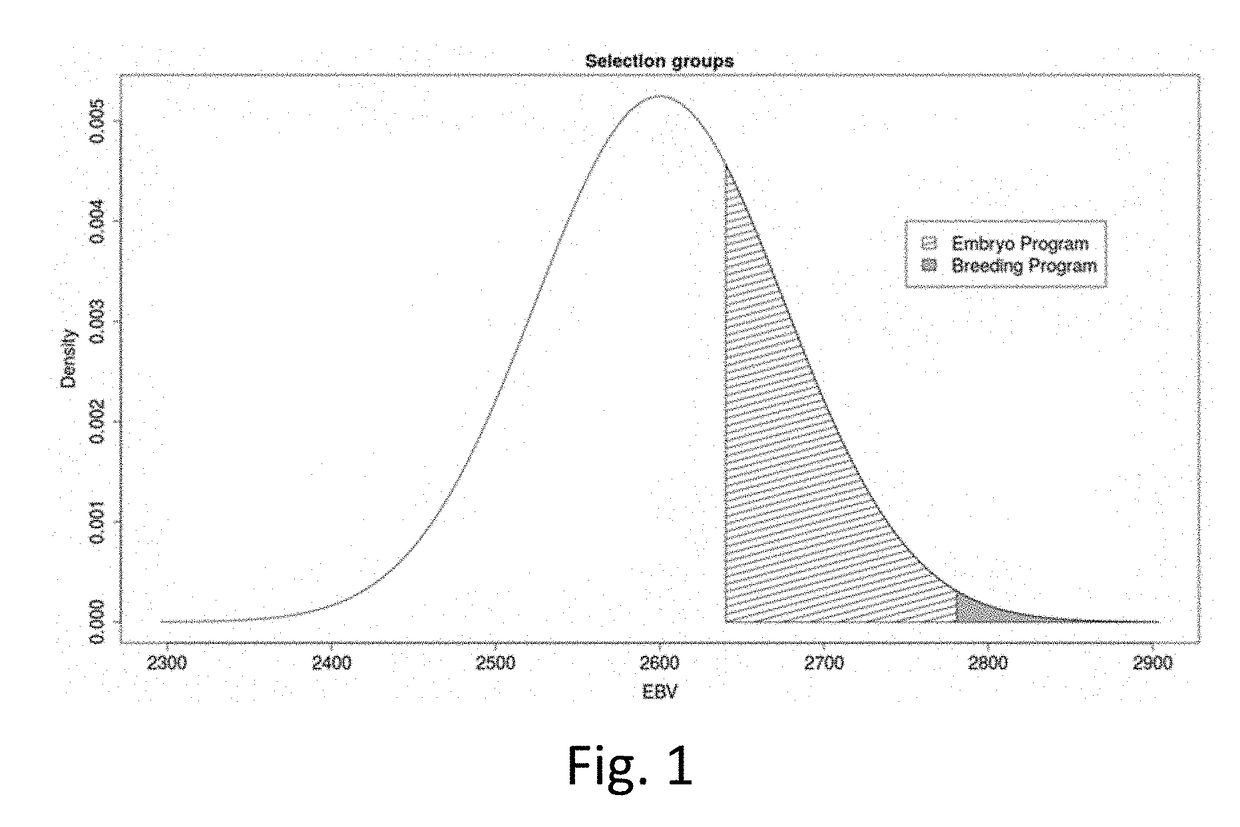Methods of Genomic Evaluation in Livestock
a genomic evaluation and livestock technology, applied in the field of methods of genomic evaluation in livestock, can solve the problems of limited application and limited applicability of cloning, and achieve the effect of increasing genetic progress
- Summary
- Abstract
- Description
- Claims
- Application Information
AI Technical Summary
Benefits of technology
Problems solved by technology
Method used
Image
Examples
example 1
sing Cultured Mesenchymal Stem Cells
[0104]Step 1. Production of donor embryo via IVF. Prophase I immature COCs were recovered from a peripubertal Holstein heifer using a TVOR system. The immature COCs were brought into the laboratory and placed into an IVM culture system. After an overnight culture period, oocytes that progressed through meiosis I and were morphologically normal, were used in IVF. The mature oocytes were placed into IVF drops and fertilized with a specific concentration of capacitated sperm from a Holstein bull. Zygotes (day 1) were placed into traditional co-culture system and cultured to uterine stages of development by day 7-8 of culture. An embryo was transported to a recipient heifer farm where it was non-surgically transferred into a synchronized recipient female. The pregnancy was monitored on a regular and scheduled basis via transrectal real time ultrasonography.
[0105]Step 2. Amniocentesis to obtain amniocytes. On day 76 of the pregnancy, amniocentesis was ...
example 2
sing Cultured Fibroblasts
[0116]The materials and methods employed in Example 1 were used to obtain cloned embryos from a second embryo donor, with the following exceptions: 1) DNA extraction and genomic analysis (as described in Step 4, above) were performed using mesenchymal stem cells obtained on day 5 of culture (as obtained in Step 3, above); and 2) the cloned embryos were created using cryopreserved fibroblasts (as obtained in Step 3, above) instead of mesenchymal stem cells. Additionally, each cryovial of fibroblasts was thawed in a 37° C. water bath for 1 minute, 1-2 days prior to cloning, transferred into a 15 ml centrifuge tube, and then processed in accordance with Step 5, above.
example 3
f Amniocytes to Increase Genetic Progress
[0117]In the following example, the effects of amniocentesis and cloning on genetic progress in a herd, line or genetic nucleus were evaluated using the following parameters and assumptions.
Parameters
[0118]σP=Phenotypic standard deviation[0119]h2=Heritability[0120]σA=√{square root over (h2)}*σP (Additive genetic / genomic standard deviation)[0121]p=Proportion of selected animals[0122]r=Accuracy of selection[0123]z=Quantil[0124]i=z / p (Intensity of selection)[0125]ΔG=i*√{square root over (h2)}*σP*r
Assumptions
[0126]# additive genomic standard deviation
sA=76
# Capacity for recipients
N=6000
[0127]# number of selected individuals
Nsel=150
[0128]# cloning—this gives the number of clones per female
Nclones=10
[0129]# gestation length in days
GL=285
# Gestation day at Amniocentesis
AD=74
[0130]# per spot in the barn: how many days of the year is an animal not pregnant?
# Days to pregnancy for recipient
DP=32
[0131]# Days from taking sample to genomic test results (G...
PUM
| Property | Measurement | Unit |
|---|---|---|
| diameter | aaaaa | aaaaa |
| length | aaaaa | aaaaa |
| distance | aaaaa | aaaaa |
Abstract
Description
Claims
Application Information
 Login to View More
Login to View More - R&D
- Intellectual Property
- Life Sciences
- Materials
- Tech Scout
- Unparalleled Data Quality
- Higher Quality Content
- 60% Fewer Hallucinations
Browse by: Latest US Patents, China's latest patents, Technical Efficacy Thesaurus, Application Domain, Technology Topic, Popular Technical Reports.
© 2025 PatSnap. All rights reserved.Legal|Privacy policy|Modern Slavery Act Transparency Statement|Sitemap|About US| Contact US: help@patsnap.com

